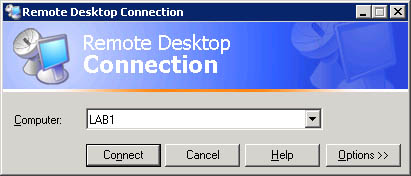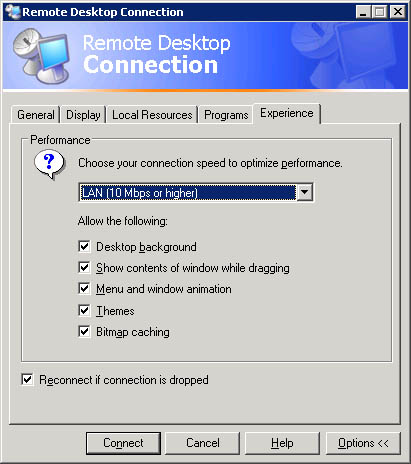Client Features
Several new client features provide improved management of terminal servers and Windows Server 2003 “based computers.
Improved User Interface
Most of these new features provide substantial improvements to the client user interface:
-
Remote Desktop Connection.
The Terminal Services client, called Remote Desktop Connection (RDC), provides substantial improvements over previous releases, including greater functionality through a simplified user interface. RDC is the same program that's used to connect to a Windows XP Professional “based computer running Remote Desktop, and it can be used to connect to previous versions of Terminal Services, including Microsoft Windows NT 4.0 Terminal Server Edition and Windows 2000. To use RDC, simply type the name of the remote computer and select Connect, as shown in Figure 7-1.
Figure 7-1. Users use Remote Desktop Connection to connect to remote computers.

-
Moving between a remote session and the desktop.
By default, a remote session is full screen and high color . The Connection Bar at the top of a full-screen RDC session lets you move easily between the remote session and the local desktop.
-
Customizing the remote connection.
If you want to change the various options for configuring the remote connection, a tabbed property sheet allows you to modify settings such as display options, local resources to redirect, and programs to run on connection.
-
Optimize performance over lower-bandwidth connections.
To optimize performance over lower-bandwidth connections, you can choose your connection speed and strip away unneeded components of the remote session ”for example, themes, bitmap caching, and animation. These choices are made using the Experience tab of the Remote Desktop Connection dialog box, as shown in Figure 7-2.
Figure 7-2. You can customize your connection for the bandwidth that's available.

-
No separate Connection Manager.
Connection Manager is no longer necessary because its functionality has been enhanced and integrated directly into the RDC. This enables users and administrators to save and open connection settings files, which can be used locally or deployed to other users. A password that is saved is securely encrypted and can be decrypted only on the computer on which it was saved.
-
Automatic reconnects.
To better protect against network dropouts ( especially in wireless and dial-up environments), RDC attempts to reconnect to a server when a network interruption causes the session to be lost.
-
Client resource redirection.
Remote Desktop Connection supports a wide variety of data redirection types. For security reasons, either the client or the server can disable each of these. A security alert is displayed when file system, port, or smart card redirection is requested ; the user can cancel the connection or disable the redirection at that time.
Client Resource Redirection Features
Unless specified in the following list, client resource redirection features are available only to clients connecting to the Windows Server 2003 family or to computers running Windows XP Professional. Any computer that can run Remote Desktop Connection can use these new features:
-
File System.
Client drives, including network drives, are mounted inside the server session. This lets users open or save files on their own computers' disk drives , in addition to opening and saving files on the server.
-
Ports.
Client serial ports can be mounted on the server. This enables a variety of hardware on the client computer to be accessed by software on the server.
-
Printers.
All printers installed on the client are visible to the server ”including network printers. With Windows 2000 Terminal Services, only locally connected printers were redirected. Redirected printers are given names that are easier to read. For example, users might see printername on printserver (from clientname) in session 9 . In Windows 2000, they would have seen _printserver_printername/clientname/Session 9 . Printer redirection also works when connecting to Windows 2000 “based servers.
-
Audio.
Sounds such as error and new mail notification events are redirected to the client.
-
Smart card sign-on.
A smart card that contains Windows logon credentials can provide those credentials to a Windows Server 2003 remote session for logon. This feature requires a client operating system that can recognize the smart card first: Windows 2000, Windows XP, or Windows CE .NET.
-
Windows keys.
Key combinations such as Alt+Tab and Ctrl+Esc are sent to the remote session by default. The Ctrl+Alt+Del combination is always interpreted at the client computer for security reasons. These key combinations also work when the client is connected to a Windows 2000 “based terminal server, but only when the client is using Windows NT “based client operating systems. They do not work with Windows 95 “based or Windows 98 “based clients.
-
Time zones.
An RDC client computer can provide its time zone to the server, or users can manually set their own time zones. This lets an administrator use one server for multiple users across different time zones. This feature is also helpful for applications that support features such as calendars. The feature is off by default because it relies on a properly set time zone on the client computer.
-
Virtual Channels.
Virtual Channels can be used to move various types of data between client and server computers. This feature is available in both Windows Server 2003 and Windows 2000 Server. Information about using Virtual Channels is available from the MSDN developer program at http://msdn.microsoft.com/.
Client Deployment Options
Remote Desktop Connection is built into Windows XP and Windows Server 2003. If you want to install RDC on client computers that don't yet have it installed, use one of the following options:
-
Use tools such as Microsoft Systems Management Server or Windows 2000 Group Policy to publish/assign the Windows Installer “based RDC.
-
Create a client installation share on Windows Server 2003. (This can also be done with Windows 2000 Server.)
-
Install directly from the Windows XP or Windows Server 2003 CD, using the Perform Additional Tasks selection from the CD's autoplay menu. (This does not require installing the operating system.)
-
Download the RDC from http://www.microsoft.com/windowsxp/remotedesktop.
Note
Remote Desktop Web Connection is an improved safe-for-scripting ActiveX control/COM object. It can be used by application service providers (ASPs) and other organizations that want to deploy Web pages built with Web applications that include Win32 components. Also, a Windows CE version of RDC is included in the Windows CE .NET Platform Builder to give Windows CE hardware vendors the option of including it with their devices.
| |
| Top |
EAN: 2147483647
Pages: 153